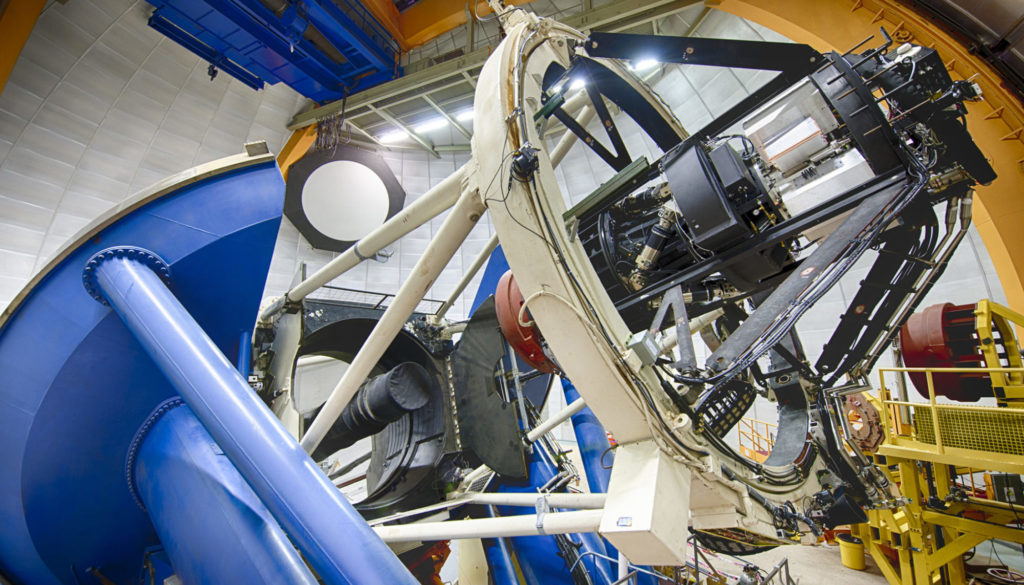Texas A&M Astronomers Celebrate First Papers From Dark Energy Survey Data
Texas A&M University astronomers are among the hundreds of scientists worldwide celebrating the first fruits from the Dark Energy Survey (DES), a five-year global effort to map the southern sky in unprecedented detail with the ultimate goal of explaining the universe’s accelerating expansion.
Earlier today (March 10), the U.S. Department of Energy-funded DES collaboration unveiled three papers announcing two different discoveries. Two of these papers originate from different continents and detail rare dwarf satellite galaxy candidates, while a third reports no detectable signal of dark matter. The common thread? Each hinges on the researchers’ use of publically available data taken during the survey’s first year as the crux of its analysis.


“The galaxies discovery is fairly exciting, especially since it comes after only about 20 percent of Dark Energy Survey data has been obtained, meaning that more of these are likely to be detected in the next few years,” said Texas A&M astronomer Darren DePoy, deputy director of Texas A&M’s George P. and Cynthia Woods Mitchell Institute for Fundamental Physics and Astronomy and director of the Charles R. ’62 and Judith G. Munnerlyn Astronomical Laboratory, as well as project scientist for the survey’s primary instrument, the 570-megapixel Dark Energy Camera (DECam). “These are also the places in the universe with the highest dark-matter density, which makes them good places for further investigation.”
Texas A&M astronomer Louis Strigari, a member of the Mitchell Institute and the Department of Physics and Astronomy faculty in 2014, is among the lead authors of a joint DES/Fermi Large Area Telescope (LAT) mission-driven study indicating no significant excess of gamma-ray emission associated with the new survey objects, thereby implying no hints for new physics in the form of particle dark matter. Even though no signal was reported, Strigari notes this joint study demonstrates that new astronomical discoveries from optical telescopes can be quickly translated into tests of fundamental physics.
“Understanding how these dwarf galaxies came to be is a mystery that theorists are trying to solve,” Strigari said. “Independently, these galaxies have proven to be invaluable targets in the search for new physics in the form of particle dark matter.”
The Fermilab paper — submitted to arXiv on March 9 — also includes DePoy and fellow Munnerlyn Lab members Jennifer Marshall and Ting Li, one of six graduate students to be awarded DES Builder status across the nearly 500-member international collaboration. DePoy and Marshall hold the distinction as well, which entitles each to be listed as authors on every DES collaboration-related paper released.
“It’s a coveted status bestowed in recognition of Ting’s tremendous contributions to enabling the Dark Energy Survey to be executed,” DePoy said.
DePoy and Strigari note that one of the main science drivers for another of the major international collaborations in which they are involved — the Giant Magellan Telescope — is to look at these sorts of objects and to study the distribution of dark matter in them using future instruments they plan to build within the Munnerlyn Lab.
“With future GMT observations of the faint stars that comprise these dwarf galaxies, Texas A&M is poised to make important contributions to these exciting areas of astronomy and high-energy physics,” Strigari said.
The Dark Energy Survey collaboration involves 25 institutions in six countries and spans the gamut of science and engineering in the search for answers as to why and how the universe is expanding at an accelerated rate. For background information about the survey and its latest results, visit the official DES website.
Click here to read more on all three discoveries and get links to each paper.
For additional information about Texas A&M astronomy, visit http://astronomy.tamu.edu.
# # # # # # # # # #
About Research at Texas A&M University: As one of the world’s leading research institutions, Texas A&M is at the forefront in making significant contributions to the storehouse of knowledge, including that of science and technology. Research conducted at Texas A&M represented annual expenditures of more than $820 million in FY 2013, ranking Texas A&M in the top 20 of the National Science Foundation’s most recent survey of research and development expenditures among U.S. colleges and universities. Recently reported FY 2014 research expenditures exceed $854 million. That research creates new knowledge that provides basic, fundamental and applied contributions resulting in many cases in economic benefits to the state, nation and world. To learn more, visit http://research.tamu.edu.
-aTm-
Contact: Shana K. Hutchins, (979) 862-1237 or shutchins@science.tamu.edu; Dr. Darren DePoy, (979) 862-2082 or depoy@physics.tamu.edu; or Dr. Louis Strigari, (979) 845-7746 or strigari@physics.tamu.edu
The post Texas A&M Astronomers Celebrate First Papers From Dark Energy Survey Data appeared first on Texas A&M College of Science
